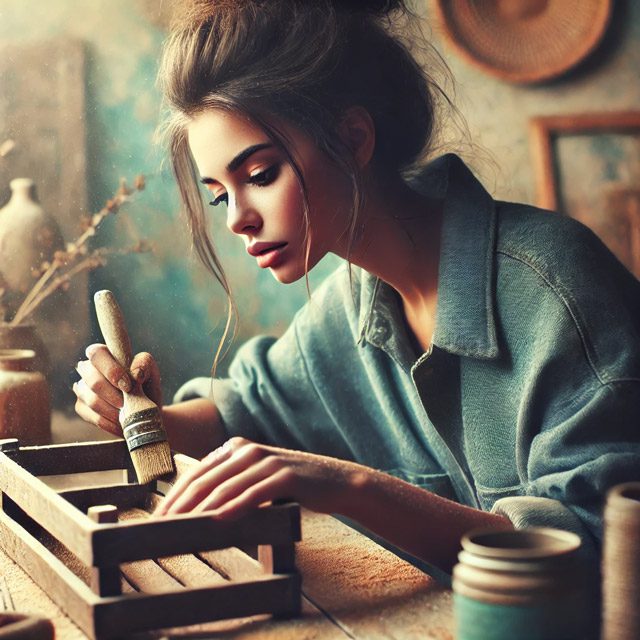

Upcycling has become the buzzword for breathing new life into old, discarded items. But let’s be real—upcycling is just a clever way of transforming trash into something beautiful. And that’s what makes it so exciting! Instead of discarding, we’re encouraged to get creative, turning odds and ends into personalized decor, furniture, and even fashion. With the rise of DIY upcycling projects and eco-friendly crafting, people are finding ways to repurpose what would otherwise be waste. But why should we care? Upcycling has perks for the planet, our wallets, and our creativity.
The upcycling movement brings together resourcefulness and style, making sustainable living feel fresh and achievable. From eco-conscious design to quirky fashion, upcycling is proof that anyone can create beauty from the unexpected. And in a world increasingly aware of waste, upcycling offers a refreshing perspective on living sustainably without compromising style. So, isn’t it time we embrace “trash art” as a genius approach to waste reduction?
The Origins of Upcycling: From Necessity to Creative Expression
Historically, upcycling was driven by necessity. During the Great Depression, every bit of fabric, metal, or wood was used until it was completely worn out. People found ways to reuse everything, whether patching up clothes, repurposing worn fabrics for new uses, or converting broken household items into functional replacements. Over time, though, this practical habit evolved into an art form. People began to see the potential in items otherwise labeled as junk, transforming them into pieces with new purpose and charm.
Unlike recycling, which involves breaking down materials for reuse, upcycling enhances the value of these items by creatively transforming them into something unique. For example, an old wooden ladder can become a quirky bookshelf, or an unused suitcase can find new life as a vintage coffee table. These aren’t just DIY projects; upcycled furniture and decor add personality and a sense of story to spaces in ways that mass-produced items simply can’t match. And this emphasis on transformation is what sets upcycling apart—it turns overlooked materials into works of art with depth and character.
There’s a special beauty in turning “waste” into something that wows. Imagine walking into a room where vintage wine bottles have been transformed into pendant lights, or where an old, weathered door now serves as a stylish dining table. These upcycled pieces don’t just add personality to a space; they serve as conversation starters and give people a chance to appreciate the unexpected potential of items that might otherwise end up in the trash.
Upcycling in Interior Design and Beyond
Upcycling isn’t just a fringe trend; it’s influencing the very heart of modern interior design. Today, it’s more than just a personal hobby; it’s become a stylish statement and a solution to the fast-furniture cycle of constant buying and discarding. Designers and companies like Patagonia, Eileen Fisher, and even high-end brands like Stella McCartney are increasingly incorporating upcycling into their sustainable practices, appealing to eco-conscious consumers who are looking to reduce their footprint while still embracing beautiful, functional design.
What’s particularly interesting is how upcycling has grown to reflect a broader lifestyle shift. With upcycled furniture, people can curate a space that not only reflects their personal style but also aligns with their values. Each piece has a story—of where it came from, the hands that transformed it, and the care that went into making it beautiful again. While it’s undoubtedly trendy, the essence of upcycling runs deeper than mere aesthetics; it’s about making thoughtful, creative choices that respect the planet and create meaningful, functional art.
For those new to upcycling, starting small can be both fun and impactful. Common household items like mason jars, wooden crates, or even broken frames offer endless possibilities for creative reuse. A mason jar can be transformed into a planter or candle holder, adding a rustic, charming touch to your space while also cutting down on waste. Or consider repurposing a wooden crate as a wall-mounted shelf; with a bit of sanding and paint, it can bring character and functionality to any room. These small projects make sustainable decor accessible and empower everyone to make a positive impact without needing advanced crafting skills.
The Benefits of Upcycling for the Planet and Wallet
Upcycling beautifully marries sustainability and style, offering advantages that go beyond aesthetics. Not only does upcycling reduce waste, but it also supports a zero-waste lifestyle, helping us see “trash” as a valuable resource rather than a nuisance. For the environmentally conscious, this is where upcycling truly shines: it’s an effective waste reduction strategy that doesn’t rely on industrial processing, helping to cut down on our carbon footprint in a practical and tangible way.
Let’s not overlook the financial benefits, either! Many upcycling projects cost little to nothing, making them an ideal way to save money while creating something both functional and beautiful. For instance, upcycled furniture often involves repurposing materials like old pallets or reclaimed wood, which are either inexpensive or free. Even paint, hardware, or small embellishments for these pieces are minimal investments compared to buying new, pre-made furniture.
In fact, some people have turned upcycling into a profitable side business, selling their unique creations on platforms like Etsy, where there’s a growing market for sustainable goods. From small items like upcycled jewelry to larger pieces like furniture, these handmade items attract eco-conscious consumers who want something original and environmentally responsible. By upcycling, not only do these creators offer something distinctive, but they also build a community of like-minded people who value creativity and sustainability.
Upcycling as an Artistic Movement
Upcycling goes beyond personal projects; it’s also a form of artistic expression and even activism. Many artists use upcycling as a way to address environmental issues, turning discarded materials into thought-provoking pieces that comment on consumerism, waste, and sustainability. Some of these creations are large-scale installations, like sculptures, murals, or even entire exhibits made entirely from recycled materials. These projects serve as visual reminders of the impact of waste while also encouraging people to rethink their consumption habits.
What makes upcycling especially impactful in today’s climate-conscious culture is its artistic element. Upcycled art doesn’t just stand out because of its materials; it tells a story of transformation, resilience, and re-imagination. Each piece becomes a conversation about finding beauty and purpose in unexpected places. In this way, upcycling becomes more than just a craft or a hobby; it becomes a statement, a way to influence others, and a form of art that challenges people to see the world in new ways.
Practical Tips for Upcycling Success
For anyone looking to dive into upcycling, there’s no need to feel intimidated. Start small and focus on projects around the home that are both fun and practical. You could use an old mirror frame as a chalkboard, repurpose wooden pallets into a coffee table, or turn vintage suitcases into stylish storage. With a little sanding, painting, and some added hardware, these items can take on a whole new look while preserving their original charm.
Experimenting with colors, textures, and finishes will help you develop a personal style. Don’t be afraid to get creative and try unconventional ideas—you might surprise yourself with what you can come up with! And if you’re looking for inspiration, try browsing through thrift shops, yard sales, or even your own garage. Upcycling is all about seeing possibilities where others might see junk, so take risks and think outside the box. The best part? There’s no right or wrong way to upcycle, only endless opportunities to create something new.
The Future of Upcycling: Trends to Watch
As more people recognize the environmental impact of their choices, upcycling trends are shaping product design and home decor in exciting ways. Designers are increasingly exploring sustainable materials and techniques to create items that are not only beautiful but also eco-friendly. For instance, reclaimed wood and vintage textiles are becoming popular materials, and companies are seeking ways to incorporate upcycled materials into their manufacturing processes.
Looking forward, the future of upcycling holds exciting potential. With increasing awareness around environmental issues, upcycling could become a staple in modern design, reshaping our relationship with both consumption and waste. And as these practices continue to evolve, we might start to see more support from governments and businesses, with policies and incentives encouraging sustainable manufacturing and consumer choices. Upcycling is more than a trend; it’s an inspiring movement that encourages us all to think more critically about the impact of our actions on the planet.
Embrace the Genius of Trash Art
Upcycling embodies creativity, environmental stewardship, and practicality in one. It’s an accessible, enjoyable way to combat waste, save money, and surround ourselves with unique pieces that tell stories. As Ann Zwinger once said, “Creativity is making marvelous out of the discarded.” Embracing upcycling allows each of us to participate in this transformation, one project at a time, finding new value and beauty in what others may overlook.
Key Takeaways
- Upcycling transforms waste into functional, stylish decor, making it an ideal choice for sustainable living.
- DIY upcycling projects and eco-friendly crafting encourage a zero-waste lifestyle.
- Upcycling benefits both the planet and the wallet by reducing waste and saving on costs.
- As an artistic movement, upcycling allows individuals to create statement pieces that challenge our perception of waste.
- The future of upcycling looks bright, with new trends making sustainable choices more accessible and inspiring.
FAQs
- What is upcycling, and why is it popular?
Upcycling is creatively repurposing old items, popular for promoting sustainable, eco-friendly living. - How is upcycling different from recycling?
Recycling breaks materials down, while upcycling transforms them into something useful without extensive processing. - What are some easy DIY upcycling projects?
Try repurposing jars, frames, or old crates for simple, beginner-friendly projects. - Can upcycling help save money?
Yes, upcycling often uses free or cheap materials, making it budget-friendly and creative. - Is upcycling sustainable?
Absolutely! It reduces waste and supports a zero-waste lifestyle, encouraging eco-conscious choices.







